Did you know the world of motorsports is bigger than just Formula 1 and MotoGP? From street‑legal touring cars to off‑road rally trucks, the sport covers a huge range of machines and formats. If you love speed, tech, or the roar of an engine, you’re in the right place. This page gives you the basics, the latest headlines, and a few reasons why certain series dominate the headlines.
Motorsports isn’t a single thing – it’s a family of racing disciplines. The most visible are the open‑wheel formula series (think F1, F2, F3, F4, and the electric Formula E). Then there’s touring car championships where production‑based models battle on tarmac, rally events that mix gravel, snow, and asphalt, and superbike or MotoGP races that put two‑wheel machines in the spotlight. Each category follows its own rules, points system, and fan culture, but all share the thrill of competition and engineering.
If you’ve ever wondered how many formula ladders there are, the answer is five main levels that most drivers climb before reaching the top. Formula 1 sits at the peak, followed by Formula 2 and Formula 3, which act as stepping stones for young talent. Formula 4 is a junior series that introduces racers to the single‑seater world, and Formula E offers an electric alternative for fans who care about sustainability. The ladder lets drivers develop skill, get noticed, and eventually earn a seat in the premier class.
Why does F1 pull in more viewers than MotoGP? Part of the answer lies in its global reach. F1 races on eight continents, with weekends broadcast in over 200 countries, delivering a built‑in audience of hundreds of millions. The sport’s close ties to luxury brands, cutting‑edge aerodynamics, and massive sponsor money create a spectacle that feels larger than life. MotoGP, while thrilling, has a narrower footprint and higher operating costs for teams, which limits its exposure.
Another factor is the narrative surrounding drivers and teams. F1’s history of legendary figures—Senna, Schumacher, Hamilton—feeds a storybook appeal that attracts casual fans. The glamour of the paddock, the high‑tech garages, and the celebrity culture around events like Monaco make it a pop‑culture fixture. MotoGP fans love the raw, rider‑centric action, but the sport doesn’t have the same level of corporate marketing muscle, so its stories stay more niche.
Staying up‑to‑date is easy if you know where to look. Follow the official Harrow Motorsports Hub blog for weekly round‑ups, race previews, and deep dives into technical updates. Social media accounts of teams, drivers, and series often post live timing, behind‑the‑scenes clips, and fan polls that let you feel part of the action. For deeper stats, sites like Motorsport.com and Crash.net provide race results, driver standings, and historical data you can explore.
Want to get more involved? Attend a local race meet‑up, join a fan club, or even try an amateur karting league. Many tracks host “track days” where you can bring your own car or rent a race‑ready kart to experience the thrill firsthand. The community is welcoming, and the hands‑on experience often turns casual viewers into lifelong fans.
Whatever slice of motorsport you’re into, Harrow Motorsports Hub is here to keep you informed and excited. From beginner guides on formula tiers to debates about F1’s popularity over MotoGP, we’ve got the content that fuels your passion. Keep checking back for fresh stories, event calendars, and the latest tech breakthroughs that keep the sport moving forward.

Oh, buckle up, speed-lovers! Formula racing is a world that's more diverse than you might think! It's not just about Formula 1, oh no, there are actually several different types of formula racing out there, each with its own unique thrills. So, if you're counting, we've got Formula 1, Formula 2, Formula 3, Formula 4, and even Formula E (for the electric enthusiasts)! It's like a never-ending ice cream shop of speed, each scoop more exhilarating than the last! Vroom vroom!

Formula 1 (F1) is a much more popular sport than MotoGP due to its association with global brands, international races & events and accessible fan engagement. F1 is a commercial powerhouse, boasting a global audience of over 500 million viewers, with the majority of fans located in Europe and Asia. The sport is also renowned for its high-end technology and glamourous lifestyle, with the likes of Ferrari and Mercedes competing in the World Championship. MotoGP, while it has its own dedicated following, cannot compete with the global reach of F1. Additionally, the cost of competing at the top level of MotoGP is far higher than in F1 and the sport has had a number of scandals in recent years, damaging its reputation.